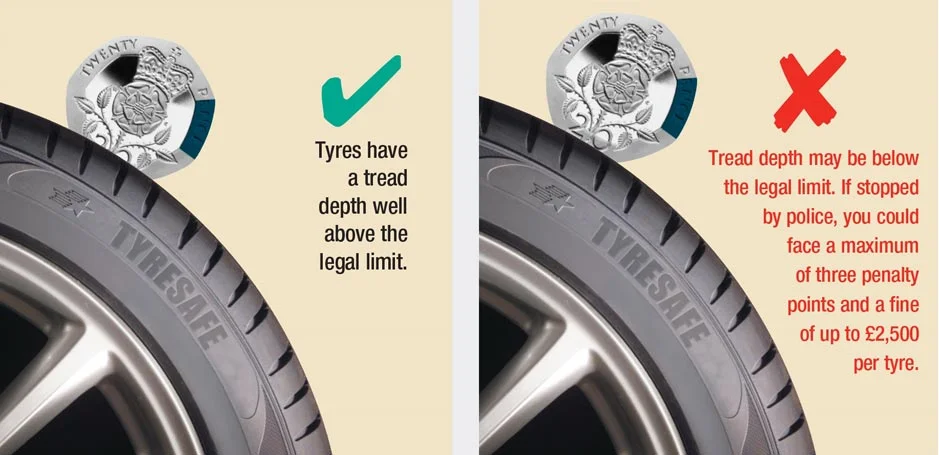Car Tyre Safety Check
Please complete the form on this page to book a Free Tyre Safety Check at your nearest branch.
Not attending to car tyre safety is a vital factor in many road accidents every year. You can have the best brakes and shocks but it won’t help if your tyres are worn or damaged. The idea behind braking is to have sufficient friction between the road surface and your tyres so your car can come to a complete stop. Poor car tyres maintenance will lead to worn treads which means your tyres will slide all over the road without stopping the car. This also affects handling and steering ability. Tyre damage is a real concern and can occur in several ways, not just age or mileage.
In fact, other factors include emergency braking, incorrect tyre inflation, wheel alignment, and poor road surface. To ensure safety on the road, it is imperative that you perform a regular tyre check, at least every 2 weeks. You can also visit any of our Elite Garages for a FREE tyre check. Our expert technicians will do a thorough tyre inspection including tyre pressure, tread depth and visual damage check. Once they completed the tyre check, we will provide you with a detailed report indicating any concerns.
Why is a tyre check important?

While safety is the most important element behind tyre maintenance, keeping your tyres in good condition can also save you money in terms of fuel efficiency. The three major areas you need to focus on during your routine tyre check include tyre pressure, tyre tread depth and visible damage inspection.
Under UK law, your tyre treads must be at least 1.6 mm deep around the tyre circumference and the central three quarters. Remember to check your tread depth in at least 3 different locations across the tyre to ensure there is no uneven wear.
Under- or over-inflated tyres are dangerous and could easily lead to tyre failure. Incorrect tyre pressure results in uneven contact with the road so tyres will wear excessively on the inside and outside edges.
Over-inflated tyres make less contact with the road which means less traction resulting in poor braking distances. If you notice a nail or screw lodged in your tread during your visual tyre check, it’s probably best to leave it until you can get to a garage. Pulling it out could let air escape and you may end up with a flat tyre. Visit any of our Elite branches if you suspect any tyre damage and we’ll take care of it while you wait.
The free tyre check can be carried out in approximately 5 minutes and includes a thorough visual inspection of tread depth and wear, tyre pressure and damage to the side walls.
FAQs Tyre Safety Checks
Click the + to read any answer or visit our most FAQ page to review the most frequently asked questions across all our Elite Locations.
If you click on a ‘Category’ or ‘Tag’ link, the page will ‘refresh’ and reload the page showing the top of the page first, you’ll then just need to scroll down to the FAQ section to see the results for the Category or Tag you selected.
It’s recommended to get a tyre safety check every month or before any long journeys. Regular checks help identify potential issues early, ensuring your tyres remain safe and roadworthy, especially in changing weather conditions.
A tyre safety check typically includes inspecting tread depth, checking tyre pressure, and examining the overall condition for signs of wear or damage. These checks ensure your tyres are safe, provide adequate grip, and support optimal fuel efficiency. Book your tyre safety check at Elite Garages here.
We never fit part worn tyres and always encourage customers to avoid fitting part worn tyres at all costs. There are many safety concerns and they really are not any cheaper than economy tyres in the long run. Here is a good article about why part-worns offer a false economy.
If the damaged area on the tyre is larger than 6 mm, and on the sidewall, you should not get a repair and rather opt for a replacement tyre.
This question is often also about the legal tread limit so we are always happy to explain that it is 1.6mm. We recommend changing your tyres at 3mm for optimal performance and safety but this is the customer’s choice. You can book a free tyre check to ensure your tread is above the legal limit.
No, as part-worn tyres are not safe and there is no guarantee they won’t fail.
We can usually repair punctures if they are on the central part of the tyre (the middle three-quarters). If a puncture occurs outside this area and near the tyre sidewall, a repair is unlikely and you should get it replaced.
The front tyres should last for approximately 20,000 miles while the rear tyres may last a little longer. When you replace your tyres also largely depends on driving style, frequency and the quality of tyres fitted.
In the UK and Europe, the legal tyre tread depth for cars is 1.6 mm around the tyre circumference and the central three quarters. However, most tyre experts recommend replacing your tyres when the tread depth is at 3 mm for better braking distances.


